Lesson 40 Body Language-初中英语 八年级下册 冀教版 同步课件(共24张PPT)
文档属性
| 名称 | Lesson 40 Body Language-初中英语 八年级下册 冀教版 同步课件(共24张PPT) |
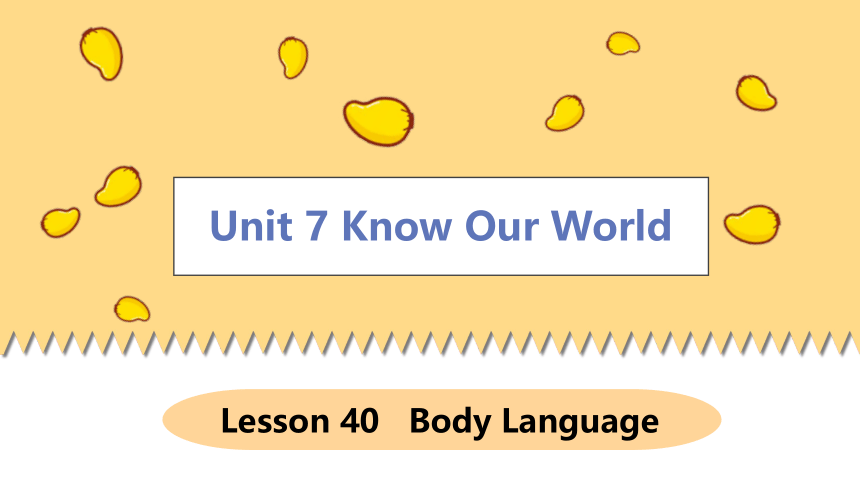
|
|
| 格式 | ppt | ||
| 文件大小 | 942.0KB | ||
| 资源类型 | 教案 | ||
| 版本资源 | 冀教版 | ||
| 科目 | 英语 | ||
| 更新时间 | 2023-05-17 17:29:06 | ||
图片预览

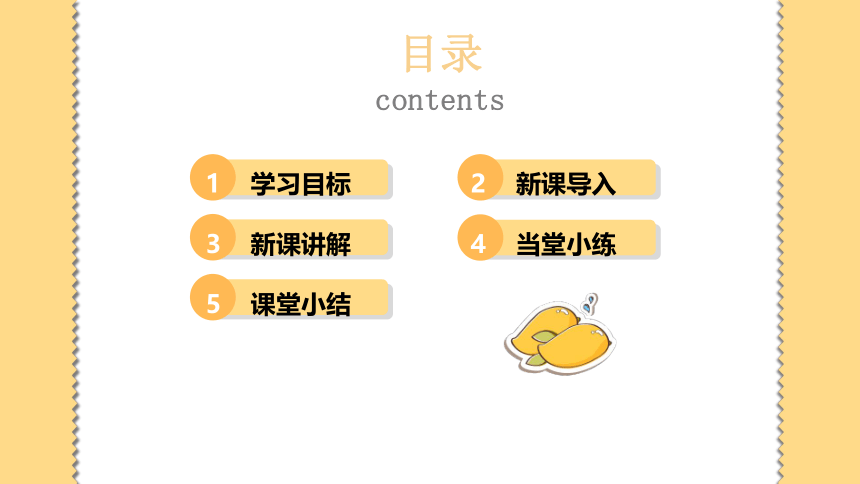
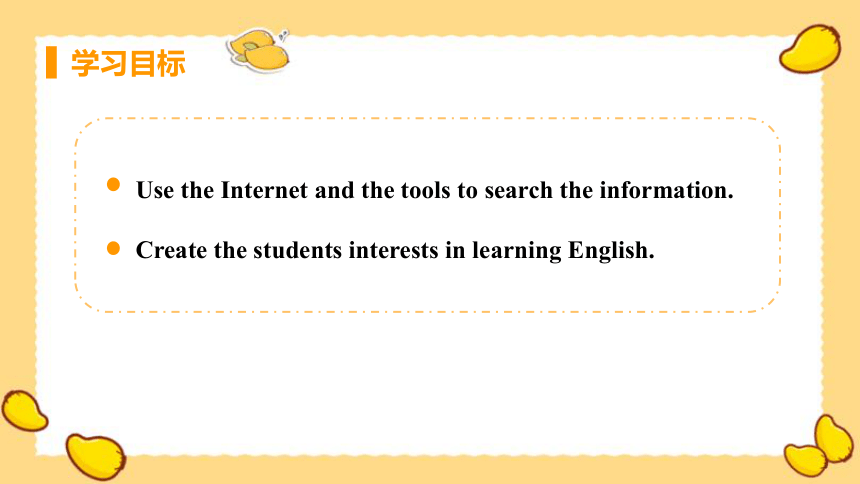
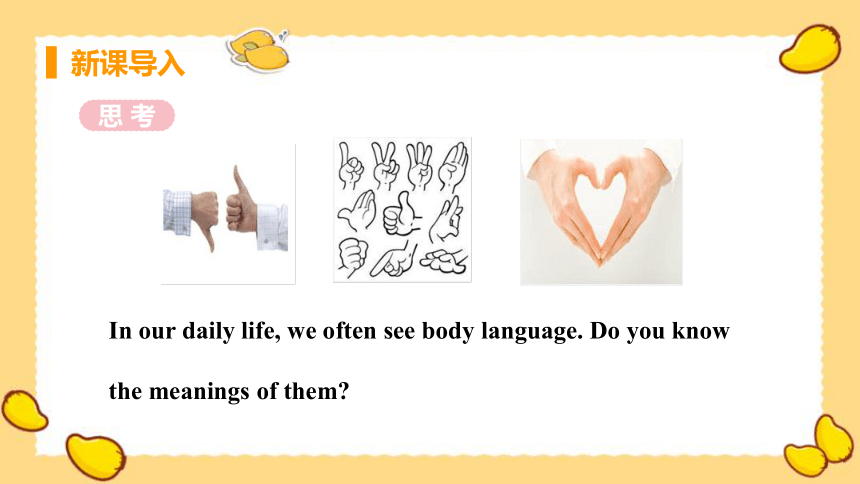
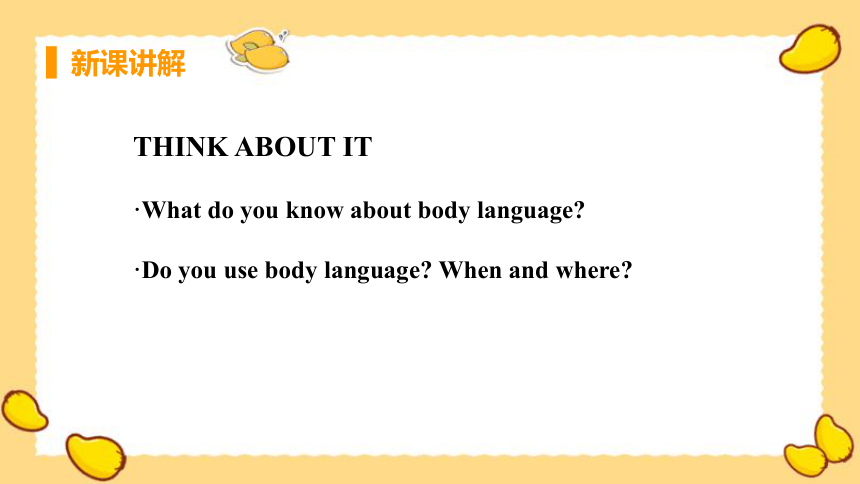
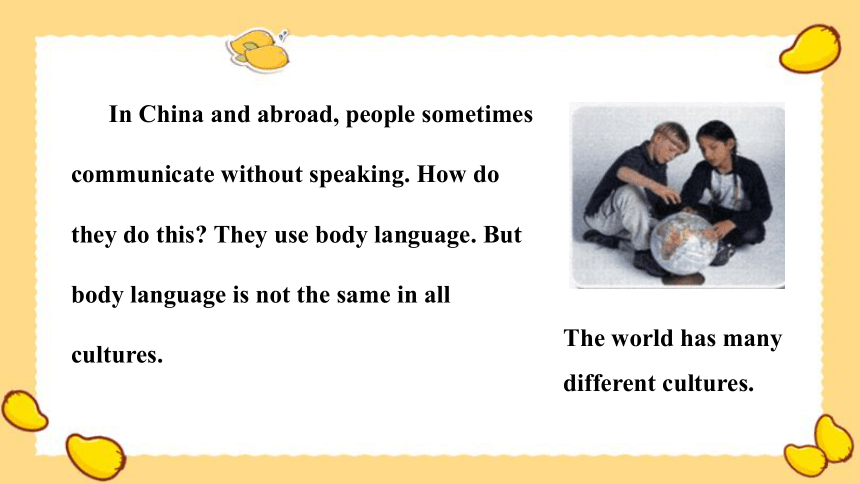
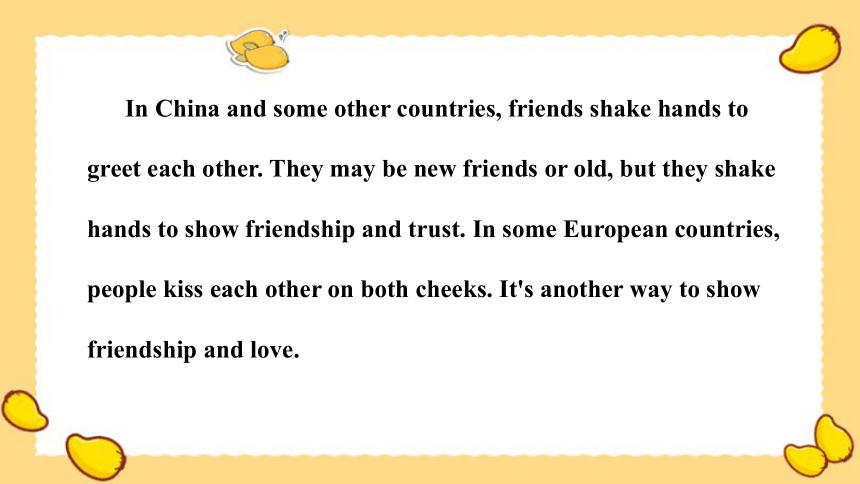
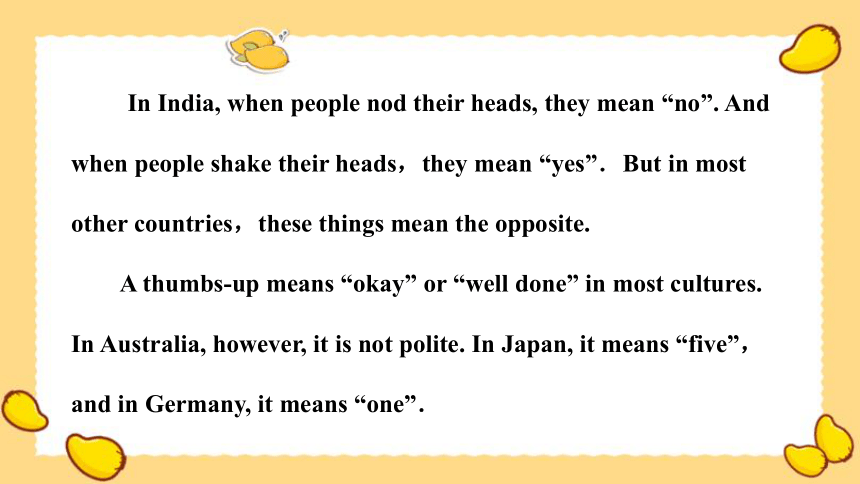
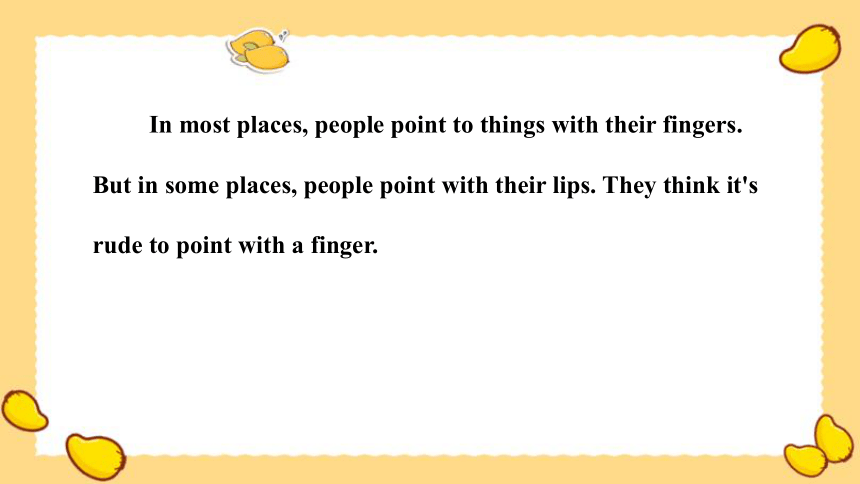
文档简介
(共24张PPT)
Unit 7 Know Our World
Lesson 40 Body Language
1 学习目标 2 新课导入
3 新课讲解 4 当堂小练
5 课堂小结
目录
contents
Use the Internet and the tools to search the information.
Create the students interests in learning English.
学习目标
思 考
In our daily life, we often see body language. Do you know
the meanings of them
新课导入
THINK ABOUT IT
·What do you know about body language
·Do you use body language When and where
新课讲解
In China and abroad, people sometimes communicate without speaking. How do they do this They use body language. But body language is not the same in all cultures.
The world has many
different cultures.
In China and some other countries, friends shake hands to greet each other. They may be new friends or old, but they shake hands to show friendship and trust. In some European countries, people kiss each other on both cheeks. It's another way to show friendship and love.
In India, when people nod their heads, they mean “no”. And when people shake their heads,they mean “yes”.But in most other countries,these things mean the opposite.
A thumbs-up means “okay” or “well done” in most cultures. In Australia, however, it is not polite. In Japan, it means “five”, and in Germany, it means “one”.
In most places, people point to things with their fingers. But in some places, people point with their lips. They think it's rude to point with a finger.
When Italians wave goodbye, it may look like “Come here!” to Americans. But the American goodbye wave looks like “no” in many parts of Europe and South America.
One body language is the same all around the world: a smile. Try it, and you’ll see!
Smiles are a universal
language.
Culture Tip
Culture refers to the beliefs, way of life, art and customs that are shared and accepted by people in a particular society. The world has many different cultures. We should learn and respect different cultures.
Language point 1
In China and some other countries, friends shake hands to greet each other.
shake hands 握手
shake sb.’s hand与某人握手
e.g.I shake her hand warmly. 我热情地与她握手。
shake hands with...与……握手
在shake hands 结构中hand必须用复数hands。
e.g. Aren’t you going to shake hands with me
你不打算和我握手吗?
Language point 2
In some European countries, people kiss each other on both cheeks.
European / j r ’p n/ n. 欧洲人 adj. 欧洲(人) 的
European用作名词时是可数名词。
一个欧洲人:a European,其复数形式为Europeans。
e.g. She is the only European in the class.
她是班上仅有的欧洲人。
Language point 3
In India, when people nod their heads, they mean “no”.
nod /n d/ v. 点头
nod 用作及物动词时,可接名词作宾语;它作不及物动词时,其后常接介词to或at,也可接动词不定式作目的状语。
e.g. He nodded his head sympathetically.他同情地点点头。
e.g. She nodded when she passed me in the street.
她在街上走过我身旁时向我点了点头。
1
Read the lesson and write true (T) or false (F).
Let's Do It !
1.In some European countries, people like to kiss each other to
show friendship and love.( )
2.Nodding your head means “yes” and shaking your head
means “no” everywhere in the world.( )
3.A thumbs up means “well done” in Germany.( )
4.When Americans wave goodbye, it looks like “no” in
some European countries.( )
T
F
F
T
Read the lesson again and complete the table.
Gestures Meanings Countries
shake hands greeting, friendship and trust
friendship and love in some European countries
nod one’s head yes in most places
in India
kiss each other on both cheeks
in China and some
other countries
no
2
shake one’s
head yes
no in most places
thumbs-up okay and well done in many
countries
not polite
five in Japan
one
in Australia
in Germany
in India
1.His mother k_____him goodbye every morning when she
leaves for work.
2.A: What do you do when you meet new friends
B: I say hello and s_____hands with them.
3.If you agree, please n___your head.
4.Italy is a E________country. It has a long history.
5.It’s p_____to say “thank you” when someone helps you.
Fill in the blanks with the words in this lesson.The first letter is given.
isses
hake
od
uropean
olite
3
Different cultures have different body language.
Work in groups. One student acts out a kind of body language while the others guess the meaning.
4
一、词语运用
1. He n________ in agreement with me.
2. The little girl k________ her mum good night before she goes to bed.
3. In my hometown, there was a big tree o________ our school.
4. Don't you know it's r________to whisper
5. The UK is an old ________ country, where there are many palaces and castles. (Europe)
odded
isses
pposite
ude
European
当堂小练
二、用方框中所给词的适当形式填空
1. I______________with Mr. Black when I first met him.
2. Please phone me___________next week.
3. He ___________ the gate of the school.
4. Everyone should behave ________ in public.
5. I_________________him regularly by letter.
point to, polite, shake hands, some time, communicate with
shook hands
some time
pointed to
politely
communicate with
重点单词:opposite,European ,nod,polite
重点短语:shake hands, point to
重点句子:In China and some other countries, friends shake hands
to greet each other.
In some European countries, people kiss each other on both cheeks.
In India, when people nod their heads, they mean “no”.
课堂小结
感 谢 观 看
Unit 7 Know Our World
Lesson 40 Body Language
1 学习目标 2 新课导入
3 新课讲解 4 当堂小练
5 课堂小结
目录
contents
Use the Internet and the tools to search the information.
Create the students interests in learning English.
学习目标
思 考
In our daily life, we often see body language. Do you know
the meanings of them
新课导入
THINK ABOUT IT
·What do you know about body language
·Do you use body language When and where
新课讲解
In China and abroad, people sometimes communicate without speaking. How do they do this They use body language. But body language is not the same in all cultures.
The world has many
different cultures.
In China and some other countries, friends shake hands to greet each other. They may be new friends or old, but they shake hands to show friendship and trust. In some European countries, people kiss each other on both cheeks. It's another way to show friendship and love.
In India, when people nod their heads, they mean “no”. And when people shake their heads,they mean “yes”.But in most other countries,these things mean the opposite.
A thumbs-up means “okay” or “well done” in most cultures. In Australia, however, it is not polite. In Japan, it means “five”, and in Germany, it means “one”.
In most places, people point to things with their fingers. But in some places, people point with their lips. They think it's rude to point with a finger.
When Italians wave goodbye, it may look like “Come here!” to Americans. But the American goodbye wave looks like “no” in many parts of Europe and South America.
One body language is the same all around the world: a smile. Try it, and you’ll see!
Smiles are a universal
language.
Culture Tip
Culture refers to the beliefs, way of life, art and customs that are shared and accepted by people in a particular society. The world has many different cultures. We should learn and respect different cultures.
Language point 1
In China and some other countries, friends shake hands to greet each other.
shake hands 握手
shake sb.’s hand与某人握手
e.g.I shake her hand warmly. 我热情地与她握手。
shake hands with...与……握手
在shake hands 结构中hand必须用复数hands。
e.g. Aren’t you going to shake hands with me
你不打算和我握手吗?
Language point 2
In some European countries, people kiss each other on both cheeks.
European / j r ’p n/ n. 欧洲人 adj. 欧洲(人) 的
European用作名词时是可数名词。
一个欧洲人:a European,其复数形式为Europeans。
e.g. She is the only European in the class.
她是班上仅有的欧洲人。
Language point 3
In India, when people nod their heads, they mean “no”.
nod /n d/ v. 点头
nod 用作及物动词时,可接名词作宾语;它作不及物动词时,其后常接介词to或at,也可接动词不定式作目的状语。
e.g. He nodded his head sympathetically.他同情地点点头。
e.g. She nodded when she passed me in the street.
她在街上走过我身旁时向我点了点头。
1
Read the lesson and write true (T) or false (F).
Let's Do It !
1.In some European countries, people like to kiss each other to
show friendship and love.( )
2.Nodding your head means “yes” and shaking your head
means “no” everywhere in the world.( )
3.A thumbs up means “well done” in Germany.( )
4.When Americans wave goodbye, it looks like “no” in
some European countries.( )
T
F
F
T
Read the lesson again and complete the table.
Gestures Meanings Countries
shake hands greeting, friendship and trust
friendship and love in some European countries
nod one’s head yes in most places
in India
kiss each other on both cheeks
in China and some
other countries
no
2
shake one’s
head yes
no in most places
thumbs-up okay and well done in many
countries
not polite
five in Japan
one
in Australia
in Germany
in India
1.His mother k_____him goodbye every morning when she
leaves for work.
2.A: What do you do when you meet new friends
B: I say hello and s_____hands with them.
3.If you agree, please n___your head.
4.Italy is a E________country. It has a long history.
5.It’s p_____to say “thank you” when someone helps you.
Fill in the blanks with the words in this lesson.The first letter is given.
isses
hake
od
uropean
olite
3
Different cultures have different body language.
Work in groups. One student acts out a kind of body language while the others guess the meaning.
4
一、词语运用
1. He n________ in agreement with me.
2. The little girl k________ her mum good night before she goes to bed.
3. In my hometown, there was a big tree o________ our school.
4. Don't you know it's r________to whisper
5. The UK is an old ________ country, where there are many palaces and castles. (Europe)
odded
isses
pposite
ude
European
当堂小练
二、用方框中所给词的适当形式填空
1. I______________with Mr. Black when I first met him.
2. Please phone me___________next week.
3. He ___________ the gate of the school.
4. Everyone should behave ________ in public.
5. I_________________him regularly by letter.
point to, polite, shake hands, some time, communicate with
shook hands
some time
pointed to
politely
communicate with
重点单词:opposite,European ,nod,polite
重点短语:shake hands, point to
重点句子:In China and some other countries, friends shake hands
to greet each other.
In some European countries, people kiss each other on both cheeks.
In India, when people nod their heads, they mean “no”.
课堂小结
感 谢 观 看
同课章节目录
- Unit 1 Spring Is Coming
- Lesson 1 How's the weather?
- Lesson 2 It's Getting Warmer!
- Lesson 3 Sun Is Rising
- Lesson 4 The Spring City
- Lesson 5 Babysitting on a Spring Day
- Lesson 6 Stories about Spring
- Unit 2 Plant a Plant
- Lesson 7 Planting Trees
- Lesson 8 Why Are Plants Important?
- Lesson 9 Gardening with Mary
- Lesson 10 Make Your Garden Grow!
- Lesson 11 Amazing Plants
- Lesson 12 Danny's Plant
- Unit 3 Animals Are Our Friends
- Lesson 13 Danny's Big Scare
- Lesson 14 Amazing Animals
- Lesson 15 The Zoo Is Open
- Lesson 16 The Pear Escaped
- Lesson 17 Save the Tigers
- Lesson 18 Friendship Between Animals
- Unit 4 The Internet Connects Us
- Lesson 19 How Do You Use the Internet?
- Lesson 20 A Computer Helps!
- Lesson 21 Books or Computers?
- Lesson 22 Travel on the Internet
- Lesson 23 The Internet--Good or Bad?
- Lesson 24 An E-mail to Grandpa
- Unit 5 Buying and Selling
- Lesson 25 Raising Money
- Lesson 26 Cookies, Please!
- Lesson 27 Business English
- Lesson 28 Ms. Liu's Great Idea
- Lesson 29 How to Push a Product
- Lesson 30 A Cookie Sale
- Unit 6 Be a Champion!
- Lesson 31 Don't Fall, Danny
- Lesson 32 My Favourite Record
- Lesson 33 2800 Years of Sports
- Lesson 34 Modern Olympics
- Lesson 35 The Dream Team
- Lesson 36 Classroom Olympics
- Unit 7 Know Our World
- Lesson 37 Let's Learn Geography!
- Lesson 38 The World Is a Big Place
- Lesson 39 Ring Up or Call?
- Lesson 40 Body Language
- Lesson 41 A Class of the World
- Lesson 42 North America
- Unit 8 Save Our World
- Lesson 43 Let's Clean Up!
- Lesson 44 Environment Clubs
- Lesson 45 Let's Sort Garbage!
- Lesson 46 Protect Our Environment
- Lesson 47 Connected to Nature
- Lesson 48 Garbage Is Interesting!
